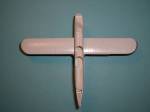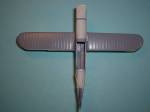Azur 1/72nd Polikarpov R-Z
|
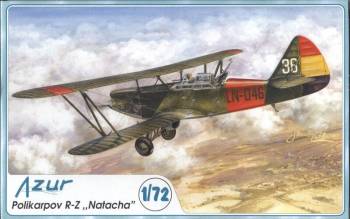 |
History
The Polikarpov R-Z was a descendent of the well-liked
R-5. It was up-engined, and in performing that modification they also
decided to try and lighten the airframe as well as making it a better
flying machine. Approximately 1100 were built and were used during the
Khalkin-Gol campaign as well as during the Spanish Civil War. In addition,
they were used primarily as bombers and reconnaissance aircraft during
the early stages of the Great Patriotic War (WW2). The Chinese also
flew a number of R-Zs.
The Kit
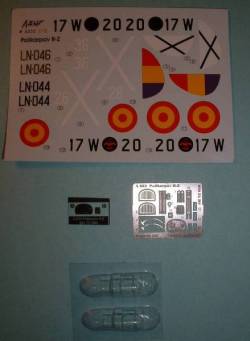 The
Azur kit of the R-Z consists of 49 injected molded pieces, a fret of
photoetch with 17 pieces on it, clear film for the instruments and vacuform
canopy pieces. In an odd twist of fate, the kit comes with no
decals for VVS machines, instead supplying decals for two machines flown
during the Spanish Civil War. The first is a Republican machine flying
with 30th Group, and the other is a Nationalist captured bird. Decals
are spot on and in register. The
Azur kit of the R-Z consists of 49 injected molded pieces, a fret of
photoetch with 17 pieces on it, clear film for the instruments and vacuform
canopy pieces. In an odd twist of fate, the kit comes with no
decals for VVS machines, instead supplying decals for two machines flown
during the Spanish Civil War. The first is a Republican machine flying
with 30th Group, and the other is a Nationalist captured bird. Decals
are spot on and in register.
Overall the molding quality is very high. While there
are no sink marks or anything else to mar the exterior of the model,
there are two badly placed sink marks on the inside of the cockpit marring
otherwise decent cockpit structure molding. It will be extremely difficult
to remove these marks without marring the molded on structure.
Unfortunately the kit isn't accurate, especially in one
major area, the lower wing. The R-Z wasn't a direct descendent of the
R-5, instead it was a refinement of that aircraft. So, while retaining
- for the most part - the upper wing, the lower wing was changed drastically.
The R-Z lower wing was narrower than the R-5, and the span wasn't as
great. Unfortunately the Azur R-Z kept the lower wing of the R-5. In
order to fix the kit's lower wing, you have to remove about 1mm from
the trailing edge, and a little over 3mm from the leading edge. In addition,
the span will have to be decreased by about 1.5mm.
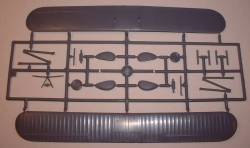 Is
this livable? Sure, but when placed next to an R-5 the similarity of
the R-Z's lower wing to the R-5 will be painfully evident. It appears
Azur based the R-Z on some older drawings, instead of referring to the
superlative Armada book on the type written by Mikhail Maslov, a known
expert on Polikarpov designs (as well as other VVS machines). The irony
is that Azur supplies a separate flyer advertising the French copy of
the Armada book. Is
this livable? Sure, but when placed next to an R-5 the similarity of
the R-Z's lower wing to the R-5 will be painfully evident. It appears
Azur based the R-Z on some older drawings, instead of referring to the
superlative Armada book on the type written by Mikhail Maslov, a known
expert on Polikarpov designs (as well as other VVS machines). The irony
is that Azur supplies a separate flyer advertising the French copy of
the Armada book.
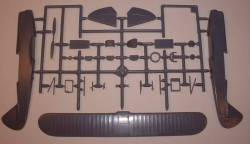 Not
only is the Armada book the best reference on the R-Z (and R-5, for
that matter) but here are also some other references that specifically
call out the difference in the lower wing (with many thanks to Alexander
Ruchkovsky): Not
only is the Armada book the best reference on the R-Z (and R-5, for
that matter) but here are also some other references that specifically
call out the difference in the lower wing (with many thanks to Alexander
Ruchkovsky):
-
Aviamaster 2'97, Kotelnikov, "Zet, the R-5 heir".
P.9: "...the chord of wings was reduced and a more speedy profile
was selected".
-
Aviacija i Kosmonavtika 4'97, M.Maslov "R-Z scout
plane". "The wings were of the same wooden construction
and with canvas skin, and retained their span but had a chord reduced
by 200mm for the upper wing and by 300mm for the lower wing."
-
Krylia Rodiny 4'99, N. Yakubovich "Natasha, fellow
combatant". Page 15: "the wing area was reduced".
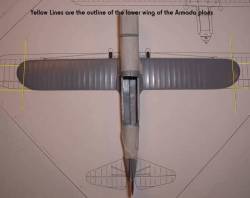 As
we see all modern Russian authors unanimously vote for the reduced wing
chord. Shavrov does not tell anything on that but his comments on the
R-Z design are very laconic and unfavorable, as if he treated it as a
minor plane. As
we see all modern Russian authors unanimously vote for the reduced wing
chord. Shavrov does not tell anything on that but his comments on the
R-Z design are very laconic and unfavorable, as if he treated it as a
minor plane.
Now to the drawings. The ones in Maslov works (both Armada
and Aik) and in Yakubovich work agree on the ways the wing and cowling
is treated. Drawings in Kotelnikov article basically repeat the Miranda
book on aircraft flown during the Spanish Civil War, a book released in
the early eighties.
There are other anomalies as well. The rear, upper fuselage
isn't tall enough, the rudder is too small and the horizontal tailpieces
are too pointy. Granted, this was while laying the parts over the Armada
plans, so it's all up to you if you want to correct these flaws. However,
the lower wing is totally inexcusable.
(In the accompanying images, the model in white plastic
is the now-Encore R-5, so you can see just how the lower wings are too
much the same. In the middle image the Encore kit is sitting on top of
the Azur, and in the right-most image the Azur kit is on top of the Encore
kit.)
The construction of the kit naturally starts with the cockpit.
There are enough pieces within the cockpit to make it a decent out of
the box build, but those amongst us wanting more detail have plenty of
room to add whatever else we want to. Once the fuselage halves are together,
then the lower wing is mounted, as is the built-up underside radiator.
After the horizontal tailpieces have been added, and the
upper wing halves glued together, painting can commence. Soviet machines
will be easy to finish since they were mostly in all-green uppers with
blue undersides. This also includes the two machines catered for on the
decal sheet. However, the cover of the Armada book shows a two-tone upper
surface camouflage, a nice departure from the typical overall green.
Once painting and decaling are finished, then the rest
of the kit can be assembled. Adding the upper wing and all struts, adding
the landing gear, etc. Unfortunately there is no rigging guide supplied
on the directions, so other reference material is a must to complete the
rigging.
Conclusion
Overall this is a very nice kit and cleanly molded. Unfortunately
Azur "missed the boat" in supplying the same lower wing as the
R-5. It is because of this and other inaccuracy issues that I can recommend
this kit only to people that either don't care about the inaccuracies,
or are willing to spend a lot of time correcting - at the very least -
the lower wing. Correcting the lower wing will result in losing the very
nicely molded-in rib detail, so somehow this will have to be reinstated.
|









|

 The
Azur kit of the R-Z consists of 49 injected molded pieces, a fret of
photoetch with 17 pieces on it, clear film for the instruments and vacuform
canopy pieces. In an odd twist of fate, the kit comes with no
decals for VVS machines, instead supplying decals for two machines flown
during the Spanish Civil War. The first is a Republican machine flying
with 30th Group, and the other is a Nationalist captured bird. Decals
are spot on and in register.
The
Azur kit of the R-Z consists of 49 injected molded pieces, a fret of
photoetch with 17 pieces on it, clear film for the instruments and vacuform
canopy pieces. In an odd twist of fate, the kit comes with no
decals for VVS machines, instead supplying decals for two machines flown
during the Spanish Civil War. The first is a Republican machine flying
with 30th Group, and the other is a Nationalist captured bird. Decals
are spot on and in register. Is
this livable? Sure, but when placed next to an R-5 the similarity of
the R-Z's lower wing to the R-5 will be painfully evident. It appears
Azur based the R-Z on some older drawings, instead of referring to the
superlative Armada book on the type written by Mikhail Maslov, a known
expert on Polikarpov designs (as well as other VVS machines). The irony
is that Azur supplies a separate flyer advertising the French copy of
the Armada book.
Is
this livable? Sure, but when placed next to an R-5 the similarity of
the R-Z's lower wing to the R-5 will be painfully evident. It appears
Azur based the R-Z on some older drawings, instead of referring to the
superlative Armada book on the type written by Mikhail Maslov, a known
expert on Polikarpov designs (as well as other VVS machines). The irony
is that Azur supplies a separate flyer advertising the French copy of
the Armada book. Not
only is the Armada book the best reference on the R-Z (and R-5, for
that matter) but here are also some other references that specifically
call out the difference in the lower wing (with many thanks to Alexander
Ruchkovsky):
Not
only is the Armada book the best reference on the R-Z (and R-5, for
that matter) but here are also some other references that specifically
call out the difference in the lower wing (with many thanks to Alexander
Ruchkovsky): As
we see all modern Russian authors unanimously vote for the reduced wing
chord. Shavrov does not tell anything on that but his comments on the
R-Z design are very laconic and unfavorable, as if he treated it as a
minor plane.
As
we see all modern Russian authors unanimously vote for the reduced wing
chord. Shavrov does not tell anything on that but his comments on the
R-Z design are very laconic and unfavorable, as if he treated it as a
minor plane. 
